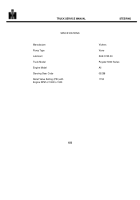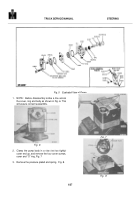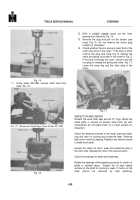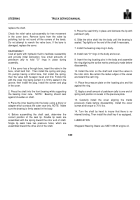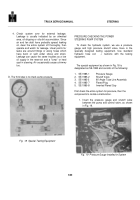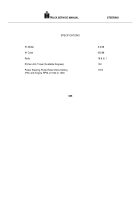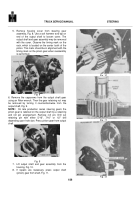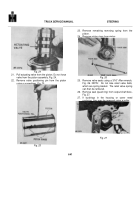TM-5-3805-254-14-P-2 - Page 640 of 894
TRUCK SERVICE MANUAL
STEERING
a. With the engine running above idle, shutoff valve
open, read the gauge while someone turns the
steering wheel. If the correct pump relief valve
pressure registers on the gauge when the
wheels reach the end of full travel, the hydraulic
system checks satisfactorily, and it is not
necessary to go any further with hydraulic check.
Trouble is probably mechanical or due to other
causes such as abnormal front-end weight.
NOTE:
System with a shuttle valve in the cylinder may
register a sharp dropoff in pressure at end of wheel
travel; this is normal.
b. If the specified relief valve pressure is not
reached and steering is hard, our system is
failing somewhere.
c. If our first check indicates low hydraulic pressure,
we must test the components to pinpoint the
place of trouble. Leave the pressure gauge and
shutoff valve installed, front wheels stationary.
2. Check the pump first:
a. Gradually close the shutoff valve; pressure
gauge should register relief valve pressure just
before or just at closing of the valve. If it does,
the pump is working correctly.
NOTE:
Do not keep shutoff valve closed longer than 15
seconds; oil may overheat and damage pump and seals.
b. If the correct pressure does not register, the
pump is faulty. Trouble may be any of the
following:
seized or "frozen" surfaces, scoring on
end faces of gears or housing, binding, scored or
damaged teeth, rotors or vanes, dirt or stickiness
of flow control valve or pressure relief valve, a
leaky pump shaft seal.
c. A hydraulic pump requires finely machined
surfaces for operation. A clean workbench must
be used for disassembly and repair.
(Clean
wrapping paper makes a good, disposable
workbench top. )
Clean pump off with clear,
clean solvent before disassembly; blow dry with
clean air.
Lint from wiping rags can destroy the
exact fit required of some surfaces.
3. If the pump is okay, check the steering control valve:
a. Disconnect the hydraulic hose at one cylinder
port;
cap
the
end
of
the
hose
using
cap SE-1985-8 and plug the port using plug
SE19857. Leave the shutoff valve open, engine
running above idle; from a straightahead position
have
someone
turn
the
front
wheels
approximately 1/4 turn to the left or until you feel
pressure buildup; check the pressure gauge.
Approximately 1/4 steering wheel turn to the right
check gauge again. The specified relief valve
pressure should register for both directions,
indicating the steering control valve is okay.
b. If the specified pressure is not reached, the valve
is faulty; we may have hard steering in either or
both directions.
c. Valve trouble is usually internal leakage--most
often caused by worn seals.
Rusting, pitting or
scoring of surfaces with which they contact affects
greatly the life of seals. Check these surfaces
when you disassemble a valve; minor damage
can sometimes be touched up with crocus cloth;
noticeable rough surfaces require replacement of
the part.
d. Check for dirt and scoring; a valve must move
freely and without sticking. Cleanliness and care
are a must when working on a steering control
valve. Forcing or abusing closely fitted parts of
any components will probably damage them
enough to requite replacement.
4.
Assume in the first teat we found the hydraulic system
was not maintaining enough pressure to give us power
for steering, but our second test indicated the pump
was working property, Our third pressure gauge check
told us the coiitrol valve was also working correctly,
This leaves only the cylinder as the point of trouble,
providing no other troubles such as binding or friction
were missed in the previous checks. If not, we can
conclude that our trouble is in the cylinder and
proceed to locate the point of failure.
a. Cylinder trouble is usually leakage--internal due to
scored cylinder walls or broken piston rings, or
external around a bent, scored or binding piston
rod or leaky rod seals.
b. A shuttle valve sticking open will cause a loss of
pressure too. If the cylinder has a shuttle valve, be
sure to check it.
c. A cylinder functioning improperly cannot apply
sufficient power to the steering linkage. Hard
steering is the result.
633
Back to Top

